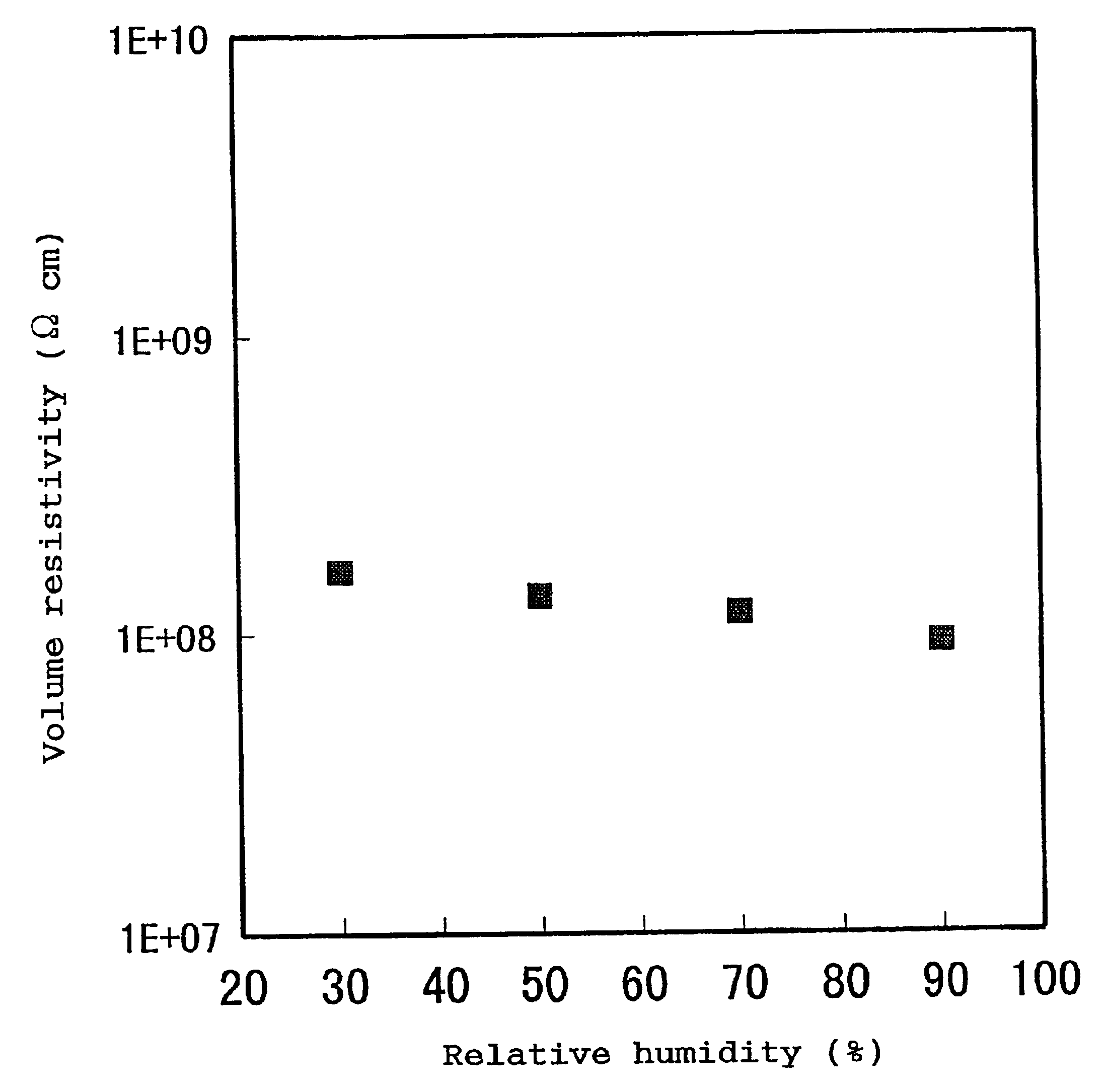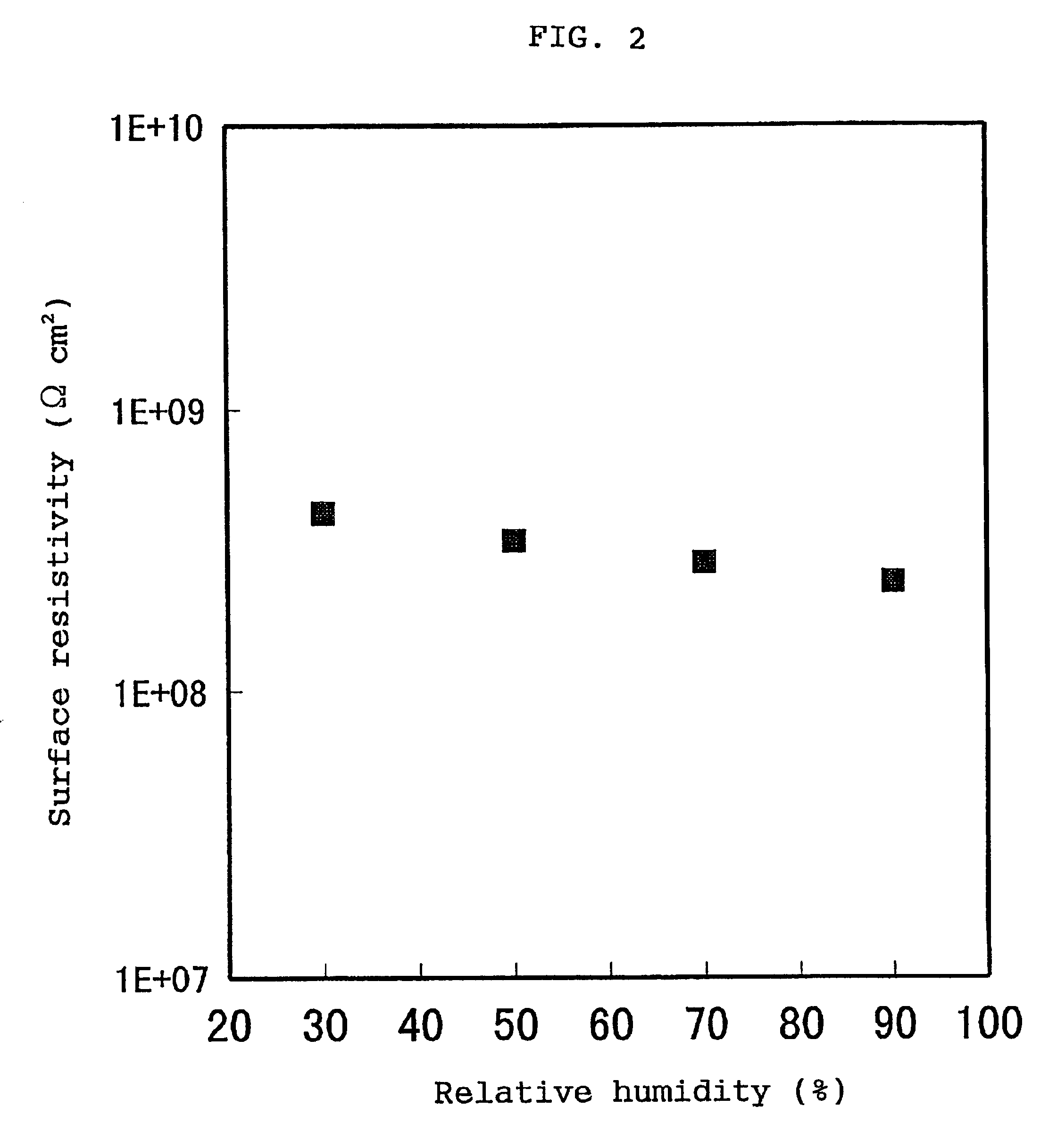If the volume resistivity varies with location, no high-quality image can be provided.
For example, if the volume
resistivity distribution of the charging roll or belt is uneven, it is difficult to equally and uniformly charge the photosensitive drum, so that the quality of the resulting image is deteriorated.
If the volume resistivities and surface resistivities of the static charge controlling members greatly vary with the change of
humidity in an ordinary use environment, no high-quality image can be stably provided.
Further, when dust, toner and / or the like are adsorbed on sheathing materials and parts of OA apparatus formed from a resin material, their appearances are impaired, or the cause of trouble is formed.
When resin-made apparatus and parts used in the fabrication processes of
semiconductor devices, LCD and the like, and films, bags and containers for packaging or conveying electronic parts such as IC and LSI adsorb dust by generation of
static electricity, the quality of the electronic parts is impaired.
However, the method (1) involves a problem that since the polyvinylidene fluoride resins have excellent anti-adhesion property, the
antistatic agent easily falls off from the surfaces of the moldings by wiping or washing the surfaces.
In addition, high
stain resistance, which is a merit of the polyvinylidene fluoride resins, is impaired.
In addition, the method involves a problem that the dependency of volume resistivity and antistatic property on
humidity becomes high.
However, the semiconductive resin composition with the conductive filler dispersed in the resin generally has an extremely uneven distribution in volume resistivity.
Therefore, such a semiconductive resin composition has involved a problem from the viewpoint of practical performance.
For that reason, there is encountered a problem that the molding and
processing ability and
mechanical strength of the resulting polyvinylidene fluoride resin composition are lowered, or its
hardness becomes too high.
However, a resin composition obtained by incorporating an inorganic
metal salt such as
lithium chloride or
potassium chloride, which is a typical
electrolyte, into a polyvinylidene fluoride resin has been difficult to lower its volume resistivity to 1×1012 Ωcm or lower, since these inorganic
metal salts are only slightly soluble in PVDF.
There has also been a problem that aggregate of the inorganic
metal salt added in excess forms the cause of
fish eye.
When kneading is conducted at a higher temperature or for a longer period of time in order to fully dissolve the inorganic metal salt in the polyvinylidene fluoride resin to prevent formation of the aggregate, the resin and / or the
electrolyte is decomposed to impair the mechanical properties and appearance of the resulting moldings.
In the case of a deliquescent inorganic metal salt such as a
lithium salt, the resulting resin composition becomes hygroscopic when such a metal salt is filled in a great amount.
Therefore, this case involves problems that the volume resistivity of the resin composition greatly varies with the change of
humidity, and that the surface of the resulting molding becomes sticky due to the deliquescence of the metal salt bled out.
However, this method has involved problems that the Young's modulus of the resin is markedly lowered, and that the surface of the resulting molding becomes sticky due to the
electrolyte and
solvent bled out.
However, this
coating material is easy to fall off by washing and is hence difficult to retain its antistatic effect for a long period of time.
Further, since most
quaternary ammonium salts, particularly,
quaternary ammonium halides are poor in
heat stability, disadvantages such as foaming and coloring arise in the resulting moldings when such a quaternary ammonium salt is kneaded with a polyvinylidene fluoride resin, the
processing temperature of which is as high as 220 to 270° C., to melt-mold the
resultant mixture.
However, the use of the polyvinylidene fluoride resin containing a great amount of the ionic electrolyte has involved such problems that
mechanical strength of the resulting molding, such as Young's modulus is lowered, that the ionic electrolyte bleeds out to the surface of the resulting molding, that molding and
processing are difficult and that cost is increased.
Accordingly, it has been difficult to control the volume resistivity of the polyvinylidene fluoride resin, particularly, to a volume resistivity of 1×1010 Ωcm or lower by only adding the ionic electrolyte.
In addition, such an ionic electrolyte as described above has been difficult to stably, uniformly and precisely develop the volume resistivity within a range of 104 to 1012 Ωcm, preferably 105 to 1010 Ωcm and also been hard to make the variation of the volume resistivity by the change of environmental
moisture small even when it is used in combination with a conductive filler such as
carbon black.
Since many inorganic
metal salts and quaternary ammonium salts are easy to bleed out under a high-humidity environment, they have involved problems that
metallic impurities on the surface of a
static electricity-controlling packaging material used in packaging or conveyance in, for example, a fabrication process of
semiconductor devices form the cause of the provision of rejected products, and that in a transfer roll or belt installed in an image forming apparatus of the electrophotographic
system, its
surface layer undergoes a change in volume resistivity due to the reduction of the ionic electrolyte in the resin, resulting in deterioration of
image quality.
 Login to View More
Login to View More 


